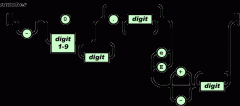[摘要]本文是对Android 之 json数据的解析(jsonReader)的讲解,对学习Android编程技术有所帮助,与大家分享。
json数据的解析相对而言,还是比较容易的,实现的代码也十分简单。这里用的是jsonReade方法来进行json数据解析。
1.在解析之前,大家需要知道什么是json数据。
json数据存储的对象是无序的“名称/值”对的集合。和其他的数据存储方式相比,json数据的可读性,可扩展性,编码难度,解码难度都有一定的优势。在json数据中,
对于一个对象:
(1)一个对象以“{”(左括号)开始,“}”(右括号)结束。
(2)每个“名称”后跟一个“:”(冒号);
(3)“‘名称/值’ 对”之间使用“,”(逗号)分隔。
对于一个数组:
(1)一个数组以“[”(左中括号)开始,“]”(右中括号)结束。
(2)值之间使用“,”(逗号)分隔。
下面是android官方给出的一组json数据示例:
[ { "id": 912345678901, "text": "How do I read JSON on Android?", "geo": null, "user": { "name": "android_newb", "followers_count": 41 } }, { "id": 912345678902, "text": "@android_newb just use android.util.JsonReader!", "geo": [50.454722, -104.606667], "user": { "name": "jesse", "followers_count": 2 } } ]在代码中,如果直接定义json数据,需要在代码中对 “ 使用 \ 转义。上面json在代码中的形式为:(在java代码中,创建一段json数据,“ 符号需要转义)
private String jsonDate = "[" + "{\"id\": 912345678901," + "\"text\":\"How do I read JSON on Android?\"," + "\"geo\":null," + "\"user\":{\"name\":\"android_newb\",\"followers_count\":41}}," + "{\"id\": 912345678902," + "\"text\":\"@android_newb just use android.util.JsonReader!\"," + "\"geo\":[50.454722,-104.606667]," + "\"user\":{\"name\":\"jesse\",\"followers_count\":2}}" + "]";1. 使用JsonReader方法解析Json数据对象,你需要创建一个JsonReader对象.
2.然后使用beginArray()来开始解析 [ 左边的第一个数组。
3.再使用beginObject()来开始解析数组{中的第一个对象。
4.对于直接的数据可以直接得到解析到的数据,但对于在json中嵌套了数组的数据,需要在写一个解析方法。
5.在解析完成后,别忘用endArray(),endObject()来关闭解析。
package com.mecury.jsontest; import java.io.IOException; import java.io.StringReader; import android.util.JsonReader; import android.util.JsonToken; public class JsonUtils { public void parseJson(String jsonDate) throws IOException{ //创建JsonReader对象 JsonReader jsReader = new JsonReader(new StringReader(jsonDate)); jsReader.beginArray(); while (jsReader.hasNext()) { readMessage(jsReader); } jsReader.endArray(); } public void readMessage(JsonReader jsReader) throws IOException{ jsReader.beginObject(); while(jsReader.hasNext()){ String tagName = jsReader.nextName(); if (tagName.equals("id")) { System.out.println("name:"+jsReader.nextLong()); }else if (tagName.equals("text")) { System.out.println("text:"+jsReader.nextString()); }else if (tagName.equals("geo") && jsReader.peek()!=JsonToken.NULL) { readDoubleArray(jsReader); }else if (tagName.equals("user")) { readUser(jsReader); }else { //跳过当前值 jsReader.skipValue(); System.out.println("skip======>"); } } jsReader.endObject(); } //解析geo中的数据 public void readDoubleArray(JsonReader jsReader) throws IOException{ jsReader.beginArray(); while(jsReader.hasNext()){ System.out.println(jsReader.nextDouble()); } jsReader.endArray(); } //由于读取user中的数据 public void readUser(JsonReader jsReader) throws IOException{ String userName = null; int followsCount = -1; jsReader.beginObject(); while (jsReader.hasNext()) { String tagName = jsReader.nextName(); if (tagName.equals("name")) { userName = jsReader.nextString(); System.out.println("user_name:"+ userName); }else if (tagName.equals("followers_count")) { followsCount = jsReader.nextInt(); System.out.println("followers_count:"+followsCount); } } jsReader.endObject(); } }对上面的内容解析的输出:
11-22 06:59:52.441: I/System.out(5329): name:912345678901 11-22 06:59:52.441: I/System.out(5329): text:How do I read JSON on Android? 11-22 06:59:52.461: I/System.out(5329): skip======> 11-22 06:59:52.461: I/System.out(5329): user_name:android_newb 11-22 06:59:52.471: I/System.out(5329): followers_count:41 11-22 06:59:52.481: I/System.out(5329): name:912345678902 11-22 06:59:52.491: I/System.out(5329): text:@android_newb just use android.util.JsonReader! 11-22 06:59:52.500: I/System.out(5329): 50.454722 11-22 06:59:52.500: I/System.out(5329): -104.606667 11-22 06:59:52.510: I/System.out(5329): user_name:jesse 11-22 06:59:52.510: I/System.out(5329): followers_count:2
 相关文章
相关文章![php CI 实战教程:[5]用curl获取json并解析](/images/defaultpic.gif)

 精彩导读
精彩导读 热门资讯
热门资讯 关注我们
关注我们
